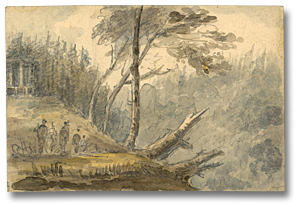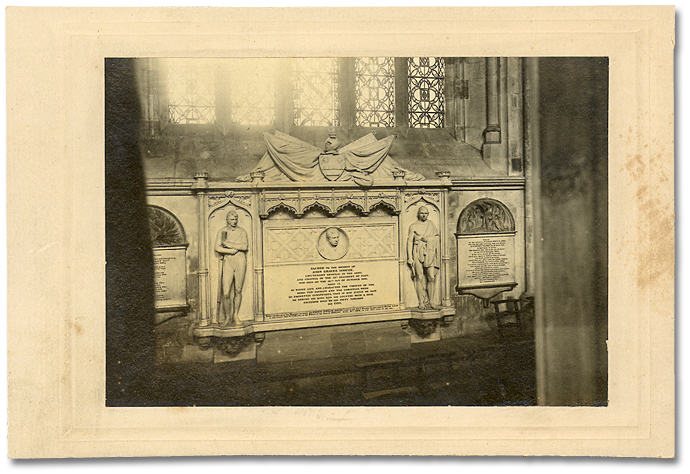
Going Home to England
Simcoe's relationship with Lord Dorchester, the Governor General, had been deteriorating for some time and this, combined with his bouts of ill health, led him to request a leave of absence to return to England.

Click to see a larger version (167K)
Castle Frank near York, July 20, 1796, (detail)
Elizabeth Simcoe, (1766-1850)
pen/paper
Reference Code: F 47-11-1-0-238
Archives of Ontario, I0007090
On the 14th July, a letter arrived at York informing Simcoe that the frigate "Pearl" would arrive at Quebec in the beginning of August to take him and his family home.
On her last day at Castle Frank, Wednesday July 20th, 1796, Elizabeth took time to make one last sketch of her Canadian home.
Elizabeth spent the night at the garrison in York, visiting and saying goodbye to friends.
At 3 o'clock on July 21st, the Simcoes boarded the "Onondaga".
|
“Took leave of Mrs. McGill & Miss Crookshank. I was so much out of spirits I was unable to dine with her. She (Mrs. McGill) sent me some dinner, but I could not eat, cried all day.” - July 21st, 1796 |
After brief stops along the way, most notably in Montreal, they arrived in Quebec on August 5th, 1796, setting sail for England on September 10th. Ten days later, they had their last glimpse of Newfoundland.
Elizabeth's great Canadian adventure was over.
She was delighted to be reunited with her four older children and quickly settled back to life at Wolford. Between 1798 and 1804, she gave birth to four more children - two sons and two daughters.
![Watercolour: Wolford Chapel, England, [ca. 1796] (detail)](pics/6536-300.jpg)
Click to see a larger version (128K)
Wolford Chapel, England, [ca. 1796] (detail)
Elizabeth Simcoe, (1766-1850)
Watercolour
Reference Code: F 47-11-1-0-297
Archives of Ontario, I0006536
Elizabeth rarely left the estate except to travel occasionally to London, often in the company of one of her daughters. She turned Wolford into a centre of Devon social life; indeed, invitations to gatherings at the estate were much sought after, with one guest favourably comparing a visit at Wolford to going to Court.
She continued to paint, finding many subjects close at hand.
When Colonel Simcoe was appointed Commander in Chief in India, Elizabeth made plans to follow him there. But this was not to be. Simcoe took sick in Portugal, where he had stopped off on a mission for the British Government, and was sent back to England, dying at Exeter in September 1806. Elizabeth, who had been shopping in London for clothes for India, heard the news of Simcoe's illness upon arriving home, and rushed to his bedside, arriving the day before his death.

Click to see a larger version (155K)
John Graves Simcoe Memorial; Exeter Cathedral, England (detail)
Photographer unknown
Black and white print
Reference Code: F 47-17-0-11
Archives of Ontario, I0007731
Elizabeth died 44 years later in January, 1850.
What kind of a picture are we left of Elizabeth Simcoe? Most people in the colony described her as quiet and shy, perhaps due to a slight speech impediment.
Elizabeth clearly enjoyed being the wife of the Lieutenant Governor and revelled in the social status it afforded her. Writing home to England she commented: To have everyone I see assiduous to please me and to have nothing to do but to follow my own fancy is a satisfactory mode of living . . . How happy I am!
Today, reading her diaries, what one is most struck with is her enthusiasm and curiosity. She enjoyed everything: the rough Atlantic crossing; social life in the colonies; the hardships of travelling throughout the Canadian wilderness; the opportunity to try new foods - including boiled black squirrel, coffee made from peas, and the odd chipmunk. At times, it appears that only rattlesnakes and mosquitoes gave her pause. Each experience was an adventure and offered a new opportunity for learning.
To learn more visit these other pages, or click "NEXT" below:
Elizabeth Simcoe - The Early Years | Sailing for the Canadas | Winter in Quebec City
Kingston and the Thousand Islands | Navy Hall and Niagara Falls | Travels Around the Niagara Peninsula
The Trip to York | Return to Niagara | Return to Quebec | The Final Year
Going Home to England | The Simcoe Collection | About Elizabeth's Diaries | John Graves Simcoe
Significant Events in the Early History of Canada | Acknowledgements and Sources